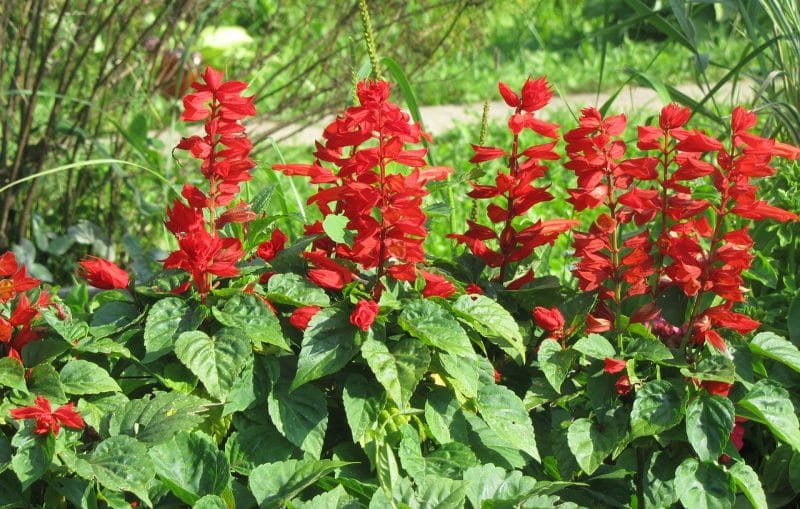To know how to cut back salvia successfully, you need to group your plants. Identify what type of salvia species you have to know the proper method for cutting them back. Remember that salvias are a diverse group of plants, and identifying their type is crucial in maintaining them successfully.
Every gardener must know how to cut back and deadhead salvias, but their maintenance doesn’t stop in pruning. You must also keep your salvias in a location that mimics their natural habitat. If your region experiences harsh climates, grow the salvias in the greenhouse to ensure healthy and vigorous plants.

How To Prune All Kinds Of Salvia Plants For Beginners
Deciduous salvias
The first group of salvias is the deciduous type, and you can differentiate these plants by having new growth at the base to replace the dead growth. Compared to other salvias, these plants will freeze or die in the winter, which means you must prune them in spring.
This way, you’ll allow the old growth to protect the new ones when the freezing temperatures come. The method of pruning deciduous salvias is probably the easiest compared to other groups. Just remember to cut them back before the stems overgrow and look messy as the dead stems twist with each other.
More than preventing an eyesore, pruning deciduous salvias will let the new growth develop vigorously because no stems will block the light and air for them. You may also benefit from cutting the branches to the ground after the flowering season to get more blooms. Cutting them to the ground is unnecessary, but you will find better-looking flowers if you cut them for rejuvenation.
Woody salvias
The next group of salvias is the herbaceous plants with woody stems. Compared to deciduous salvias, these shrubby salvias do best when you prune them after flowering. However, you don’t need to cut them to the ground as the first group.
Sometimes, pinching will suffice as long as you reach the first set of foliage on the stem. You don’t want to cut them to the ground because these plants will have a hard time growing back. And because they have an extended growing season, you can trim heavily late in fall or early winter.
Some gardeners also do some light pruning in late spring or mid-summer instead. Light pruning is best to shape your woody salvias and also as maintenance to remove the dead growth from winter. By cutting these salvias with these tips in mind, you shouldn’t face any problems with woody growth that won’t bloom healthily.
Rosette-forming salvias
The final group of salvias includes evergreen herbaceous plants that form rosettes. These salvias bloom for a long time, and their stems form more foliage and flowers than other types. The best time to cut them back is in the fall.
You want to cut the rosette-forming salvias down to the ground to help it rejuvenate itself. If you notice some dead foliage, remove them as well.
How To Deadhead Salvias Correctly
After grouping your salvias, you must also know some techniques for the deadheading itself. Cut your salvias when it’s not scorching hot, preferably early in the morning, to avoid stressing the plants. Start pruning the center stalk that has finished blooming.
You can also check those at the side if they have faded blooms. You can deadhead your salvias as you see spent stalks, but be mindful not to cut those that are just forming buds. You can also boost your plants by fertilizing them in the growing season if the flowers are underwhelming.
How To Maintain Salvias
Maintaining salvias is not limited to cutting back and deadheading them. It’s also crucial that you know their ideal conditions and practices to ensure healthy plants and blooms. And while these plants are not sensitive to challenges and problems, remember that extreme conditions or improper practices can still cause drawbacks.
Location
Remember that salvias are best for growing zones 5 to 10, depending on the type. This gives you an idea of these plants’ preferred growing location, so you must provide the best environment for them. If your area experiences fluctuating temperatures or extreme climatic conditions, it’s best to grow salvias in the greenhouse.
Salvias will thrive best somewhere with full sun and fertile, well-draining soil. It would be best to test the ground on the site and make the necessary amendments to improve its quality. And according to Michigan State University, never keep salvias somewhere lower than 50°F.
Fertilizer and water
Compared to other plants, salvias do not require feeding. However, you can mulch and compost the plants every spring to improve the area’s moisture retention and keep weeds at bay. Salvias will also benefit from maintaining soil moisture, but be mindful not to overwater your plants as this can cause rot.
Conclusion
Maintaining salvias is crucial to keep their foliage neat-looking and also encourage the plant to produce more blooms. However, you can only learn how to cut back salvia correctly if you can classify your plants into three groups. They are deciduous, woody, and rosette-forming types, which all differ in pruning techniques.
You can cut back deciduous salvias to the ground to encourage healthy blooms. On the other hand, you want to trim your woody salvias in late fall and early winter to prevent them from overgrowing woody stems. Lastly, rosette-forming salvias will benefit from cutting back in the fall.
